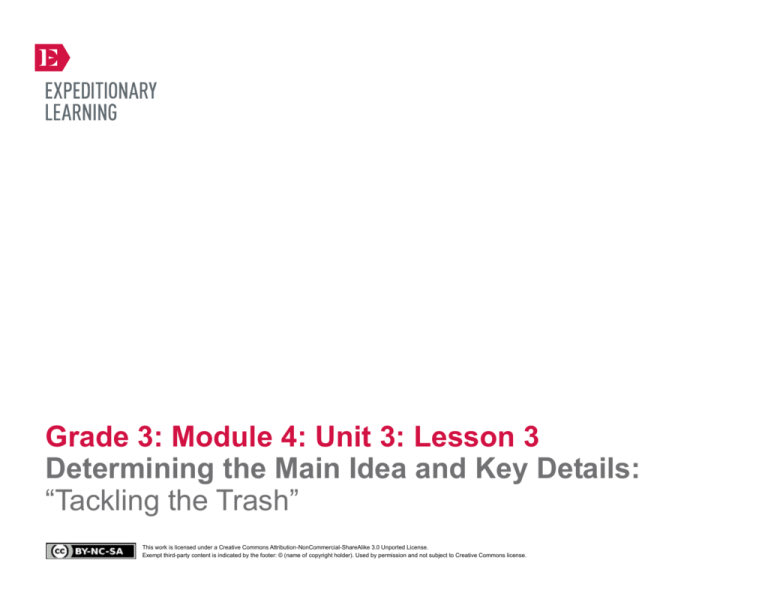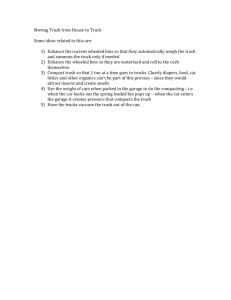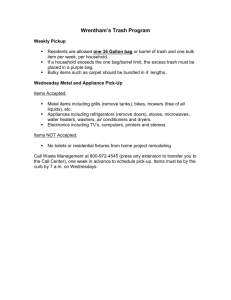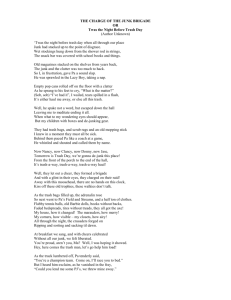
Grade 3: Module 4: Unit 3: Lesson 3
Determining the Main Idea and Key Details:
“Tackling the Trash”
This work is licensed under a Creative Commons Attribution-NonCommercial-ShareAlike 3.0 Unported License.
Exempt third-party content is indicated by the footer: © (name of copyright holder). Used by permission and not subject to Creative Commons license.
GRADE 3: MODULE 4: UNIT 3: LESSON 3
Determining the Main Idea and Key Details:
“Tackling the Trash”
Long-Term Targets Addressed (Based on NYSP12 ELA CCLS)
I can answer questions using specific details from informational texts. (RI.3.1)
I can determine the main idea of an informational text. (RI.3.2)
I can retell key ideas from an informational text. (RI.3.2)
I can tell the difference between related words and synonyms (e.g., knew, believed, suspected, heard, wondered). (L.3.5c)
Supporting Learning Targets
Ongoing Assessment
• I can determine the main idea of “Tackling the Trash.”
• Students’ annotated text “Tackling the Trash”
• I can determine the key details from “Tackling the Trash.”
• Commitment cards (from Lesson 2 homework)
Copyright © 2013 by Expeditionary Learning, New York, NY. All Rights Reserved.
NYS Common Core ELA Curriculum • G3:M4:U3:L3 • June 2014 •
1
GRADE 3: MODULE 4: UNIT 3: LESSON 3
Determining the Main Idea and Key Details:
“Tackling the Trash”
Agenda
Teaching Notes
1. Opening
• In this lesson, students share their commitment cards with partners using the Back-to-Back, Face-toFace protocol. Their ideas should be added to the Being Well Aware anchor chart and taken into
consideration for use in their VoiceThreads. Continue to prompt students to think about what their
VoiceThreads might include.
A. Engaging the Reader: Sharing Conservation
Commitments (5 minutes)
B. Unpacking Learning Targets (5 minutes)
2. Work Time
A. Determining the Main Idea of “Tackling the Trash”
(15 minutes)
B. Answering Questions about “Tackling the Trash” (10
minutes)
C. Finding Key Details and Revising the Main Idea
Statement (15 minutes)
3. Closing and Assessment
A. Sharing Ways to Be Well Aware (10 minutes)
4. Homework
A. Share three things Chad did to make a difference.
B. Continue reading your independent reading book.
C. Begin completing your Independent Reading
recording form
Copyright © 2013 by Expeditionary Learning, New York, NY. All Rights Reserved.
• Then, students read and reread “Tackling the Trash” to figure out the text’s main ideas and key details.
Jill Esbaum wrote “Tackling the Trash” in 2002. However, work by Chad Pregracke (pronounced “Pergrack-ee”) continues through his organization Living Lands and Waters. For more information, see his
website: http://www.livinglandsandwaters.org.
• As they read this text, students also focus on synonyms, in support of NYSP12 ELA CCLS L.3.5. This text
provides an opportunity to focus students’ attention on how authors use different words with the same
meaning to make their writing more interesting and precise. This work with synonyms is an important
connection that helps students build their vocabulary and their understanding of word meanings.
• Students use Determining the Main Idea and Key Details task cards to complete their synthesis of
“Tackling the Trash.” These are the same task cards that were used in Lesson 2, as well as Unit 1,
Lessons 6–11. In advance, decide whether students would benefit from having new copies of these task
cards or whether they can reuse the original ones.
• In advance: Gather highlighters or colored pencils for students to use when they complete Part 2 of the
Determining the Main Idea and Key Details task card.
• Post: Learning targets.
NYS Common Core ELA Curriculum • G3:M4:U3:L3 • June 2014 •
2
GRADE 3: MODULE 4: UNIT 3: LESSON 3
Determining the Main Idea and Key Details:
“Tackling the Trash”
Lesson Vocabulary
Materials
act out (perform), pantomime,
synonym, trash, litter, junk, clutter,
landfill, determined/determination,
grant, donate/donation
• Being Well Aware anchor chart (begun in Lesson 2)
• “Tackling the Trash” (one per student and one to display)
• Determining the Main Idea and Key Details task card (from Unit 1, Lesson 8)
• Determining the Main Idea and Key Details task card (specific to today’s lesson; answers, for teacher reference)
• Document camera
• Determining the Main Idea and Key Details anchor chart (begun in Unit 1, Lesson 6)
• Highlighters or colored pencils (one per student)
• Equity sticks
• Independent Reading recording form (from Unit 2, Lesson 4; one per student)
Copyright © 2013 by Expeditionary Learning, New York, NY. All Rights Reserved.
NYS Common Core ELA Curriculum • G3:M4:U3:L3 • June 2014 •
3
GRADE 3: MODULE 4: UNIT 3: LESSON 3
Determining the Main Idea and Key Details:
“Tackling the Trash”
Opening
Meeting Students’ Needs
A. Engaging the Reader: Sharing Conservation Commitments (5 minutes)
• Physical movement supports ELLs
and students with different learning
styles.
• Ask students to refer to the commitment cards they made for homework.
• Invite them to determine how they can act out or silently perform their commitments for one another (pantomime).
• Review the Back-to-Back, Face-to-Face protocol with students, and ask them to stand back-to-back with a partner.
• Tell students: “When I say, ‘Front-to-front,’ turn around and silently act out your commitment. Watch what your partner
does, and call out your guess. The only rule is that you have to stay in the same place.”
• Call out, “Front-to-front.” Give students 30 seconds to 1 minute to share with their partner.
• Then say, “Back-to-back” and ask students to find a new partner.
• Repeat as time permits.
• Refocus students whole group. Commend them on their efforts to be well aware. Invite the class to share some of the ways to
save water that are not yet on the Being Well Aware anchor chart. Add these to the chart.
• Remind students that they may use some of these ideas in their VoiceThread.
B. Unpacking Learning Targets (5 minutes)
• Direct students’ attention to the posted learning targets. Ask students to read them silently.
• Acknowledge that they have worked on main ideas and key details many times this year. Then ask students to turn and
discuss the following with a partner:
* “Why do you think we have spent so much time on main ideas and key details?”
• Cold call a few students to share out. Listen for ideas like: “The main idea is what the author wants you to know. If you can’t
find the main idea, you may not be learning what you are supposed to from the text. The key details help you to understand
the main idea more deeply and make sure that you got it right.”
Copyright © 2013 by Expeditionary Learning, New York, NY. All Rights Reserved.
NYS Common Core ELA Curriculum • G3:M4:U3:L3 • June 2014 •
4
GRADE 3: MODULE 4: UNIT 3: LESSON 3
Determining the Main Idea and Key Details:
“Tackling the Trash”
Work Time
Meeting Students’ Needs
A. Determining the Main Idea of “Tackling the Trash” (15 minutes)
• In support of RI.3.10, students
are asked to read this text
independently. If students need
support with the text, have them
whisper-read with their partners
or pull together a small group to
whisper-read with your support .
• Distribute “Tackling the Trash” and the Determining the Main Idea and Key Details task card. Tell students this text
tells the story of a young man named Chad Pregracke, who is well aware.
• Read the directions for Part 1 of the Determining the Main Idea and Key Details task card aloud. Tell students they will have 10
minutes to complete Part 1 of the task card.
• Encourage students to think about how they might include ideas from this text in their VoiceThread.
• Circulate and observe students as they read. Give support with decoding only when necessary.
• As students begin to work on their main idea statements, ask questions like the following to individuals, small groups, or the
whole class:
• Consider pulling small groups
for support with the text .
* “What is helping you determine the main idea?”
* “What is this text mostly about?”
• You might ask follow-up questions like:
* “How do the text features like the title, pictures, and border help you to determine the main idea?”
* “How do the illustrations along the border reinforce the main idea?”
• Refocus students’ attention whole group.
• Ask students to turn to a neighbor and share their main idea statements. If students have not yet written their main idea
statements, they can write these with their partners.
• Remind students to give their partners a chance to share ideas. Remind them that it is important to notice and discuss
differences between their ideas. Be sure students are using evidence from the text.
• Circulate and select a few strong main idea statements to share. It’s OK if these are simple first drafts as long as they have the
main idea that Chad took action on pollution by cleaning up the river around his home and getting the help of others.
• After a few minutes, call students together. Share the main idea statements that you selected.
Copyright © 2013 by Expeditionary Learning, New York, NY. All Rights Reserved.
NYS Common Core ELA Curriculum • G3:M4:U3:L3 • June 2014 •
5
GRADE 3: MODULE 4: UNIT 3: LESSON 3
Determining the Main Idea and Key Details:
“Tackling the Trash”
Work Time (continued)
Meeting Students’ Needs
B. Answering Questions about “Tackling the Trash” (10 minutes)
• Consider posting the questions you
ask to support visual learners .
• Display a copy of “Tackling the Text” on a document camera.
• Direct students’ attention to the displayed text.
• Ask:
* “With your partner, look over the first three paragraphs of the text. What synonyms, or words that mean nearly the same
thing, can you find for the word ‘garbage’?”
• Ask for volunteers to call out a few words they found (“trash,” “junk,” “clutter,” “litter”).
• Ask:
* “Why do you think the author used these different words for garbage?”
• Call on a volunteer. If needed, note that authors often use synonyms to make their writing more interesting and precise.
Point out the first sentence in the third paragraph, “Spring floods added to the clutter.”
• Ask:
* “Why do you think that the author used the word ‘clutter’ in this sentence instead of just saying ‘trash’?”
• Again give students a few moments to think; then call on a volunteer to respond.
• Direct students to the last paragraph on the first page. Read the sentence: “When his boat was full, he took the load to the
landfill.” Ask:
* “What is a synonym for ‘landfill’?”
• Cold call a few students to respond.
• Read Paragraphs 3 and 4 on the second page aloud.
• Refer students to the word donate. Tell them that sometimes people give away things like food, clothes, or money to help
people or a cause, such as cleaning up the river. The thing that they donate is called a donation.
• Ask:
* “In the fourth paragraph, which word do you think is a synonym for a donation of money?”
• Cold call partners to respond. Listen for: “grant.”
Copyright © 2013 by Expeditionary Learning, New York, NY. All Rights Reserved.
NYS Common Core ELA Curriculum • G3:M4:U3:L3 • June 2014 •
6
GRADE 3: MODULE 4: UNIT 3: LESSON 3
Determining the Main Idea and Key Details:
“Tackling the Trash”
Work Time (continued)
Meeting Students’ Needs
C. Finding Key Details and Revising the Main Idea Statement (15 minutes)
• Using silent signals (a quiet thumb,
etc.) ensures engagement by
promoting simultaneous
engagement, communicating when
students have had enough think
time, and promoting accountability.
Any student who gives the signal is
communicating readiness to share.
• Redirect students’ attention to the posted learning targets. Ask a volunteer to read the second learning target aloud.
• Tell students they are now going to complete Part 2 of the task card with their partners.
• Suggest to students that—especially on the second page—they figure out the main idea one paragraph at a time. If not
already listed, add this strategy to the Determining the Main Idea and Key Details anchor chart.
• Distribute one highlighter or colored pencil to each student.
• Give students about 10 minutes to complete Part 2.
• Circulate as students work. As needed, ask questions like:
* “Why did you select this passage as a key detail?” (Listen for approaches listed on the Determining the Main Idea and Key
Details anchor chart.)
• Students may benefit from talking
with a partner before sharing their
answers. Consider using strategies
like Think-Pair-Share.
* “What’s the important thing to learn from this paragraph about how Chad Pregracke made a difference?”
• Refocus students’ attention whole group. Direct students to their main idea statement. Ask them to discuss the following
with their partners:
* “Based on the key details that you identified, would you change your main idea statement? Why or why not?”
• Circulate as students discuss. Select a few highlights to share or a few students to share their thinking.
Copyright © 2013 by Expeditionary Learning, New York, NY. All Rights Reserved.
NYS Common Core ELA Curriculum • G3:M4:U3:L3 • June 2014 •
7
GRADE 3: MODULE 4: UNIT 3: LESSON 3
Determining the Main Idea and Key Details:
“Tackling the Trash”
Closing and Assessment
Meeting Students’ Needs
A. Sharing Ways to Be Well Aware (10 minutes)
• Mixing partners for the sharing
serves two primary purposes: 1) to
encourage sharing new information
and 2) to allow students to work
with someone new. If your class
does not easily pair, either have
students share with their existing
partner or predetermine pairs.
• Tell students to turn to a new partner and share what they learned from Chad Pregracke’s story about becoming well aware.
Encourage students to use specific examples from the text.
• Use equity sticks to call on at least three students to share their ideas. Add ideas to the Being Well Aware anchor chart.
• Distribute the Independent Reading recording form to students and preview the homework.
Meeting Students’ Needs
Homework
• When Chad Pregracke decided to clean up the river, he was being well aware. Share with someone at home three things that
Chad did to make a difference. Which one of these ideas might you want to share in your VoiceThread to help others be well
aware?
• Continue reading your independent reading book.
• Begin completing your Independent Reading recording form.
Note: Students work on their Independent Reading recording form for homework across several lessons.
Copyright © 2013 by Expeditionary Learning, New York, NY. All Rights Reserved.
NYS Common Core ELA Curriculum • G3:M4:U3:L3 • June 2014 •
8
Grade 3: Module 4: Unit 3: Lesson 3
Supporting Materials
This work is licensed under a Creative Commons Attribution-NonCommercial-ShareAlike 3.0 Unported License.
Exempt third-party content is indicated by the footer: © (name of copyright holder). Used by permission and not subject to Creative Commons license.
GRADE 3: MODULE 4: UNIT 3: LESSON 3
Being Well Aware Anchor Chart
For Teacher Reference
(Continued from Lesson 2; new answers are in bold. Answers will vary based on the input of the
students from homework, the text, and past research.)
Being Well Aware
Learn More and
Educate Others
• Take pictures of the problem to share with others
Join Others
• Pass laws to encourage people to save water
• Share your story with other groups
• Work together to clean up a river (Adopt-a-Mississippi Mile)
• Ask for money for or donate money to people who are doing
good work
Conserve Water
• Limit lawn watering
• Use cool water from the shower to water plants
• Use buckets to wash cars
• Take short showers
• Use water-saving showerheads
• Limit baths
• Turn off leaky faucets
• Design houses that save water
• Drink from a cup instead of the faucet
• (Add student responses from homework.)
Protect Water
• Clean up trash near waterways
Improve Access
Copyright © 2013 by Expeditionary Learning, New York, NY. All Rights Reserved.
NYS Common Core ELA Curriculum • G3:M4:U3:L3 • June 2014 •
10
GRADE 3: MODULE 4: UNIT 3: LESSON 3
“Tackling the Trash”
Copyright © 2013 by Expeditionary Learning, New York, NY. All Rights Reserved.
NYS Common Core ELA Curriculum • G3:M4:U3:L3 • June 2014 •
11
GRADE 3: MODULE 4: UNIT 3: LESSON 3
“Tackling the Trash”
Copyright © 2002 Highlights for Children, Inc., Columbus, Ohio. All rights reserved. Used by permission.
Copyright © 2013 by Expeditionary Learning, New York, NY. All Rights Reserved.
NYS Common Core ELA Curriculum • G3:M4:U3:L3 • June 2014 •
12
GRADE 3: MODULE 4: UNIT 3: LESSON 3
Determining the Main Idea and Key Details Task Card
Answers for Teacher Reference
Learning target: I can determine the main idea and key details of an informational text.
Part 1: Determining the Main Idea
1. Read the text.
2. In your own words, what is the main idea of this text? On the back of your text, write a #1, then
write a main idea statement.
(Answers will vary. Student answers may not be this complete on the first draft. Look for something
about how Chad took action on pollution by cleaning up the river around his home and getting the
help of others.)
Part 2: Finding Key Details
1. Reread the text. As you read, highlight the key details that you think support the main idea.
(Answers will vary. Look for answer about how and why Chad cleaned up the river and how he
involved others. Some examples follow.)
• This time, instead of wondering why someone else didn’t clean it up, he decided to tackle a few
miles of shoreline himself.
• I could see the results day after day. It made me feel good to help my community.
• Chad got his first small grant and the encouragement he needed to find others to help.
• Chad received enough money to finish his summer’s work with several volunteers to help him.
• His goal was to clean 1,000 miles of shoreline.
• He shared his story with community groups.
• In 2000, he began hosting community-wide cleanup days.
Part 3: Revising the Main Idea Statement
1. If needed, revise your main idea statement. Write a #2 next to it. Put a ✓ if you choose not to revise.
Copyright © 2013 by Expeditionary Learning, New York, NY. All Rights Reserved.
NYS Common Core ELA Curriculum • G3:M4:U3:L3 • June 2014 •
13







